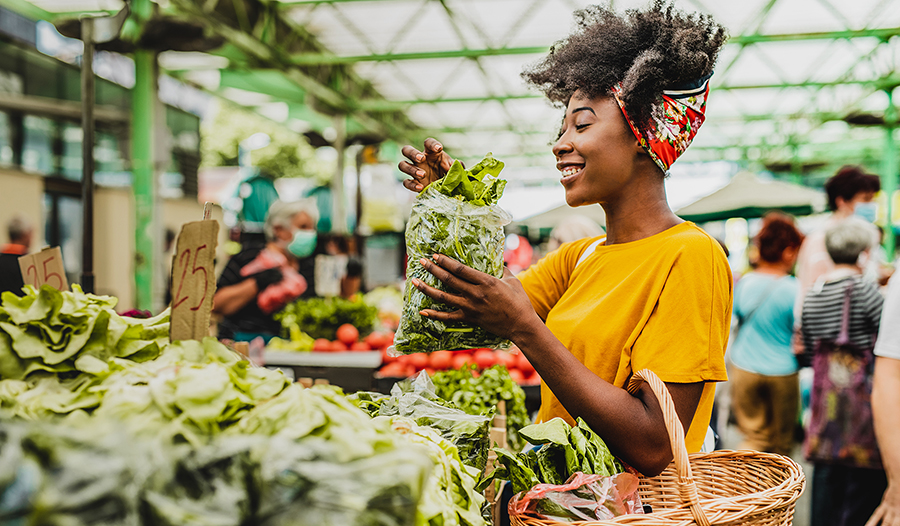Hogyan Lehet Átmenni Egy Növényi Étrendre

Valószínűleg észrevette a növényi alapú étkezés növekvő népszerűségét. Valójában egy nemrégiben készült Nielsen felmérése kimutatta, hogy az amerikaiak 39% -a aktívan próbál több növényi ételt fogyasztani. Talán a növényi alapú étrend választása felkeltette az érdeklődését, de nem biztos abban, hogy mi a legjobb módszer erre, vagy talán attól tart, hogy túl nehéz lesz ezt megtenni.
Íme egy útmutató, amely segít a növényi étrendre való áttérésben. Az induláshoz néhány területre összpontosítunk: annak meghatározása, miért, növényi alapú étrend kiválasztása, növényi alapú élelmiszerek azonosítása és a húsbevitel csökkentése.
1. Határozza meg, miért szeretne áttérni növényi alapú étrendre
Mielőtt bármilyen jelentős változást vállalna életmódjában, mindig jó ötlet egyértelműen azonosítani motivációját és céljait. Ha jól megérti, miért fontos számodra a növényi alapú étkezés, akkor jobban képes lesz fenntartani a fókuszt, és kevésbé valószínű, hogy eltéved a pályáról, ha nehézségek merülnek fel.
A növényi alapú étrend okai a következők lehetnek:
Együttérzés az állatok iránt: Sok haszonállat zsúfolt környezetben tölti az életét, ahol kevés hely van természetes viselkedésének folytatására. Gyakran szenvednek ezen a létezésen keresztül, csak azért, hogy lassú és fájdalmas halálokat elviseljenek.
Környezeti hatások csökkentése: Tanulmányok kimutatták, hogy a húsalapú étrend élelmiszer-előállítási rendszere több föld-, energia- és vízforrást igényel, mint a növényi alapú étrendé. Emellett a húsipar az üvegházhatású gázok kibocsátásának egyik legnagyobb termelője, ezért jelentősen hozzájárul az éghajlatváltozáshoz.
Az egészségügyi előnyök iránti vágy: Kutatások kimutatták, hogy a növényi alapú étkezés hatékony lehet a fogyásban és csökkentheti a krónikus betegségek, például a cukorbetegség, a szív- és érrendszeri betegségek és bizonyos típusú rákok kockázatát. A növényi alapú étrend segíthet csökkenteni a vérnyomást, csökkenteni a koleszterinszintet és kezelni a vércukorszintet.
2. Döntse el, melyik növényi alapú étrend fog működni az Ön számára
- A félig vegetáriánus vagy rugalmas étkezés többnyire növényi ételeket tartalmaz, amelyek rugalmasan engedhetik meg a húst vagy állati termékeket.
- A Pescatarian egy növényi alapú táplálkozási terv, amely halat és tenger gyümölcseit tartalmaz, de húst vagy baromfit nem tartalmaz. Sok peskatárius tojást és tejételeket is fogyaszt.
- A vegetáriánus étrend nem tartalmaz húst, de különféle állati eredetű termékeket tartalmaz. A lakto vegetáriánusok tejtermékeket fogyasztanak, de nem esznek húst, halat, tojást vagy baromfit. Az ovo vegetáriánusok nem esznek húst, halat, tejterméket vagy baromfit, hanem engedélyezik a tojás fogyasztását. A lakto-ovo-vegetáriánusok tojást és tejtermékeket fogyasztanak, de nem húst, halat vagy baromfit.
- Vegán diéta kizárja az állati eredetű élelmiszereket.
3. Tervezze meg és készüljön fel növényi alapú étrend fogyasztására
Készítsen tervet arra vonatkozóan, hogy mit fogsz enni minden héten. Hacsak nincs költségvetése vegán vagy vegetáriánus étteremben étkezni minden étkezéshez, az otthon történő elkészítése kritikus fontosságú lesz a növényi alapú étrend elfogadásának sikeréhez. Tehát töltsön egy kis időt szakácskönyvek megtekintésével vagy online receptek kutatásával. Tanulja meg, hogyan kell megfelelően főzni és fűszerezni a növényi fehérjéket, hogy élvezhesse őket.
Növényi alapú élelmiszerkészletek készletre
Készítsen egészséges növényi ételeket, amelyeket enni szeretne. Nehezebb visszatérni a régi étkezési szokásokba, ha soha nem fogynak el a növényi alapú lehetőségek. Szintén könnyebb a pályán maradni, ha nincs hozzáférése az elkerülni kívánt élelmiszerekhez. Tisztítsa meg konyháját, távolítsa el az olyan tárgyakat, mint a tej- és húskészítmények.
Néhány gyakori elem, amelyet érdemes megfontolni a növényi kamrába és a hűtőszekrénybe:
- Gabona és tészta: Rizs, zab, kuszkusz, quinoa (álszemes), teljes kiőrlésű tészta, barna rizs tészta
- Bab és hüvelyesek: Borsó, lencse, edamame, tempeh, csicseriborsó, fekete bab, vesebab, fekete szemű borsó
- Liszt és sütőtermékek: Teljes kiőrlésű liszt, fehérített mandulaliszt, szódabikarbóna, kakaópor, szentjánoskenyérpor
- Édesítőszerek: Stevia, szerzetes gyümölcs, nyers agave, juharszirup, kókuszcukor
- Diófélék és magvak: Mandula, kesudió, pekándió, dió, lenmag, chia mag, szezámmag, tökmag
- Konzervek és konzervek: Kókusztej, paradicsom, zöldségleves, savanyúság, savanyú káposzta, olajbogyó, mandulavaj
- Szárított gyümölcs: Sárgabarack, kókuszpehely, datolya, mazsola, áfonya
- Fűszerek : Bazsalikom , babérlevél , cayenne , koriander, fahéj , kömény , curry , , fokhagymapor , gyömbér , himalájai só 130}, hagymapor , paprika , petrezselyem , pirospaprika pehely , rozmaring, kakukkfű, kurkuma , vanília kivonat, fehérbors
- Olajok és ecetek: Olívaolaj, kókuszolaj, szezámolaj, almaecet, balzsamecet, vörösbor-ecet, rizsecet
- Termelés: Alma, sárgarépa, zeller, lime, citrom, banán, kelbimbó, avokádó, paradicsom, hagyma, édesburgonya, cukkini, brokkoli, gomba, paprika, sötét leveles zöldségek, salátazöldek
- Hűtőszekrény és fagyasztó cikkek: Tofu, tempeh, tejmentes tej, miso, salsa, fagyasztott gyümölcsök és zöldségek.
- Egyéb élelmiszerek: Tamari, táplálkozási élesztő, tengeri moszat, citromlé, kókuszdió-aminók.
4. Kezdje csökkenteni a húsfogyasztást
Nem kell azonnal lemondani kedvenc ételeidről. Először végezzen könnyebb változtatásokat. Távolítsa el azokat az állati ételeket, amelyeket egyébként nem eszik túl gyakran. Rendben van, ha lassan kezdesz.
Kezdetben próbáld meg hetente egy nap húsmentes lenni. A húsmentes hétfők egy népszerű trend, amelyet érdemes beépíteni az induló tervébe.
Adjon hozzá további növényeket étrendjéhez
Ahelyett, hogy siralkodna azon, amit eltávolít, összpontosítson arra, amit hozzáad. Növelje az elfogyasztott zöldségek számát, így ebéd és vacsora közben körülbelül a tányér felét töltse ki. Ha levest készít, keverjen hozzá néhány babot és kelkáposztát. Ha szendvicset készít, dobjon rá néhány hajtást és uborkaszeletet.
Változtassa meg gondolkodását, ha húsról van szó
Ahelyett, hogy a húst az ételek csillagjává tenné, tedd támogató szerepet. Használjon kisebb mennyiséget belőle. Talán úgy gondoljon rá, mint köretnek. Az első hetekben, miközben a növényi fehérjék, például a lencse, a tofu vagy a tempeh használatát fedezi fel központi elemként, elkezdheti csökkenteni a hús adagméretét. Ez egy módja annak, hogy az agyat arra tanítsuk, hogy ne rögzítsék a húst, mint az étkezés magját. Akkor sokkal könnyebb lesz végül hús nélkül maradni.
Használjon jó zsírokat
Egy másik nagyszerű módja annak, hogy elterelje az elmédet a hús hiányától, ha figyelsz a zsírra. A jó zsír hozzáadása valóban kielégítővé teheti az étkezést. Válasszon olyan egészséges zsírok közül, mint az olajbogyó, dió, mag, olívaolaj, avokádó és dióvaj. Ezek növényi alapú zsírok, amelyek olyan előnyökkel járhatnak, mint a bőr megjelenésének javítása, a hormontámogatás biztosítása és a HDL (a „jó” koleszterin) szintjének növelése.
Tegye reggelit növényi alapú
Miután hozzászoktál ahhoz, hogy hetente egy nap húsmentes legyen, tegye meg a következő lépést, hogy több növényi alapú ételt adjon hozzá a hetedhez. Jó kezdési hely a nap elején - a reggeli! Ez az egyik legkönnyebb vegetáriánus vagy vegán ételek elkészítéséhez. Felverhetsz egy kis chia pudingot, vagy ihatsz avokádó pirítóst. Még néhány vegán fehérjeport is dobhat a palacsintatésztába, mielőtt felgyújtaná a rácsot. Próbálja ki az alábbi vegán palacsinta receptemet.
Használjon lépésenkénti eljárást az állati élelmiszerek eltávolítására
Érdemes kipróbálni egy ilyen tervet. Dolgozzon arra, hogy hetente csak egyszer vegyen húst, mielőtt végül megszünteti azt. Ezután kezdje el csökkenteni a tejfogyasztást. Először is helyettesítheti a tehéntejet nem tejtermékeny alternatívákkal, például mandulatejjel vagy kókusztejjel. Ezután távolítsa el a sajtot az étrendből. Innentől kezdve lépjen tovább az összes többi tejtermék, például tejszín, joghurt és szószok kiküszöbölésére. Az utolsó lépés a tojások kizárása lehet.
Szerezzen elegendő B12-vitamint
A vegánoknak és vegetáriánusoknak fennáll a B12 hiány kockázata, ami vérszegénységet vagy idegrendszeri károsodást okozhat. A B12-vitamin vegán forrásai közé tartoznak a B12-kiegészítők és a B12-vel dúsított élelmiszerek (ellenőrizze a növényi tej, szójatermékek és reggeli gabonafélék címkéit). Az, hogy a szervezet hogyan szívja fel a B12-t, attól függ, hogy milyen gyakran fogyasztja. Minél ritkábban veszi be a B12-t, annál nagyobb mennyiséget kell fogyasztania a kívánt mennyiség felszívásához.
A megfelelő B12vitamin megszerzéséhez ajánlott az alábbiak egyikét tenni:
- Egyél dúsított ételeket naponta kétszer vagy háromszor, legalább 3 mikrogramm B12-t kapva naponta.
- Vegyen be egy B12-kiegészítőt, legalább 10 mikrogramm naponta.
- Vegyen be hetente legalább 2000 mikrogramm B12-kiegészítőt.
Vegán fehérje palacsinta recept
Összetevők:
- 1 csésze teljes kiőrlésű liszt
- 1⁄4 csésze vegán fehérjepor
- 1 evőkanál. sütőpor
- 1⁄4 teáskanál. só
- 1 csésze mandulatej (vagy bármely más tejmentes tej)
- 2 evőkanál. olvasztott kókuszolaj (vagy olívaolaj)
- 2 evőkanál. juharszirup
- 1 evőkanál. tiszta vanília kivonat
Utasítások:
- Egy nagy tálban szitáljuk össze a száraz hozzávalókat.
- Keverje össze a folyékony összetevőket egy külön tálban.
- Öntsük a folyékony összetevőket a száraz összetevőkre, és addig keverjük, amíg csak néhány csomó marad. (Ne keverje túl. Ellenkező esetben a palacsintád kemény lesz.)
- Hagyja a tésztát 5 percig pihenni.
- Szükség esetén enyhén olajozzon meg egy serpenyőt, és tegye közepes-magas hőre. Miután egy csepp víz csikorog a serpenyőben, elég forró.
- Öntsön körülbelül 1/4 csésze tésztát a serpenyőbe.
- Főzzük 2-3 percig, amíg apró buborékok képződnek a palacsinta felületén, majd fordítsuk meg.
- Főzzük további 1-2 percig, amíg mindkét oldalán aranybarna nem lesz. Forrón tálaljuk.
FELELŐSSÉGKIZÁRÓ NYILATKOZAT:A jelen blognak nem célja diagnózis felállítása...




























































































